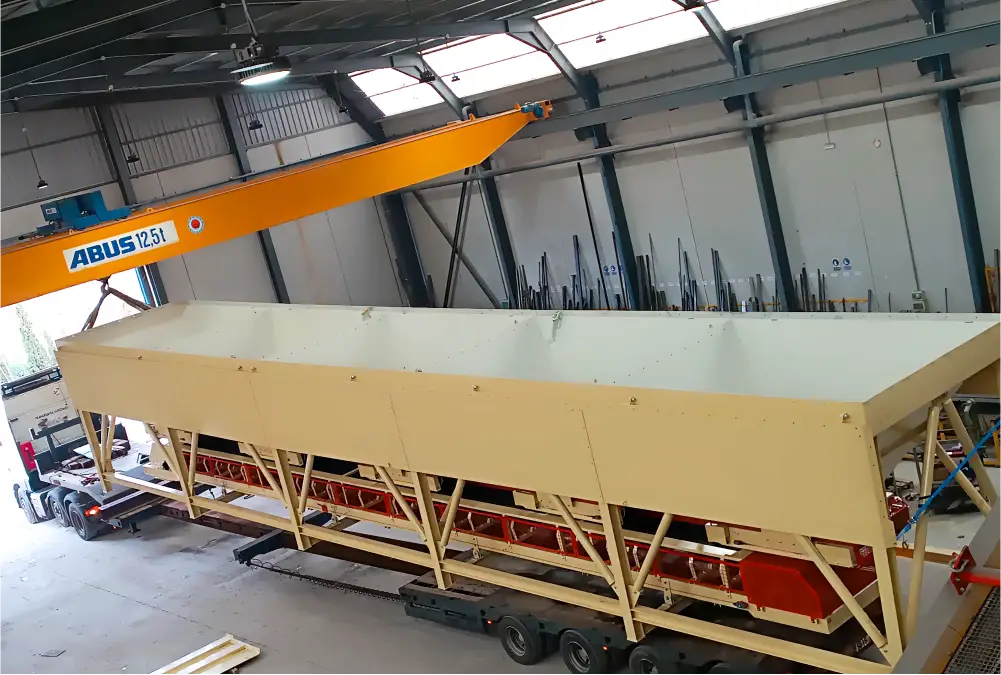Storage plays a fundamental role in any industrial facility, serving as the main axis of the production process. An efficient and organized storage system ensures smooth product output without interference, making it a key factor in the proper functioning of the system.
In an aggregate processing plant, materials of different compositions and granulometries are handled throughout the process, classified into the following categories:
- All-in-one materials – These are transported directly from the extraction site to the primary hopper. When extracted using explosives, they have considerable dimensions, making handling more challenging.
- Intermediate or semi-processed products – These materials have undergone a crushing process, reducing their size to a more manageable level.
- Plant waste – These are fine materials removed during pre-screening and are typically stored in stockpiles.
- Final commercial products – These are ready for distribution and are stored in hoppers, silos, or stockpiles, depending on the facility’s logistical needs.
Types of storage
Storage systems in a mining facility typically consist of silos, hoppers, and ground stockpiles.
What is a silo?
Silos are cylindrical, square, or rectangular storage structures made of steel sheets with a supporting structure and a foundation at the base. They have large capacities, reaching up to 3,000 m³, and are used for different granulometries. Silos can be open or closed, with the latter being more common.
To protect silos from abrasion, they are sometimes lined with rubber, wear-resistant plates, or vitrified concrete, particularly when storing concrete.
A common issue with silos, especially when storing fine materials in high-humidity conditions, is material adhesion, forming vaults that obstruct discharge. This is resolved using mechanical vibrators or compressed air cannons.
The silo’s bottom design is crucial as it directly affects storage capacity and discharge efficiency. Material extraction is typically facilitated by feeders.
What is a hopper?
Hoppers are open-top storage containers with openings at the bottom. Their capacity varies, reaching up to 300 m³. They are often covered at the top to prevent rainwater infiltration, dust emissions, and noise from material discharge.
Structurally, hoppers are usually rectangular, made of concrete or steel sheets, with a parallelepiped shape. The bottom is typically equipped with a plate feeder for material discharge.
For primary or regulating hoppers that allow machine feeding (loaders, dumpers, trucks, etc.), a small retaining wall should be installed to prevent machinery from advancing too far.
Ground stockpiles
Stockpiles on the ground are formed as a result of conveyor belt discharges. The materials stored this way are usually waste, intermediate products, or final products.
This storage method has some disadvantages, such as segregation and possible contamination of materials.
For intermediate stockpiles, pre-stock tunnels are often used. These tunnels run beneath the stockpile and are equipped with one or more feeders to facilitate feeding the conveyor belt inside.
Differences between silos and hoppers
Although both are used for storage, hoppers are generally smaller than silos. Additionally, silos are typically used for storing materials over more extended periods.
Factors to consider when purchasing silos and hoppers
Before acquiring a silo or hopper for aggregate storage, it is crucial to consider several factors to ensure an efficient, safe, and suitable investment.
At JLM Ingeniería, we specialize in designing and manufacturing storage solutions, considering the following aspects:
- Storage capacity – Calculating the volume of aggregates to be stored and production demand.
- Type of material – Taking into account granulometry, density, specific weight, and humidity.
- Design, shape, and location – Optimizing loading and unloading efficiency.
- Loading system – Choosing between point-loading systems or continuous-loading systems with bucket elevators.
- Unloading system – Selecting between gravity systems, screw conveyors, or dosing components.
- Additional systems – Implementing mechanisms to prevent compaction.
- Weighing systems
- Level monitoring systems – Monitoring stored volume and preventing overloading.
- Ease of maintenance – Ensuring simple and efficient access for maintenance operations.
Why trust JLM Ingeniería?
Choosing us as your silo and hopper supplier means opting for quality, experience, and customized solutions. We have a highly qualified team and cutting-edge technology to design and manufacture storage elements tailored to your needs.
Our attention to detail, commitment to efficiency and safety, and comprehensive after-sales service make us the best choice for ensuring the success of your industrial project.
Contact us for more information.



